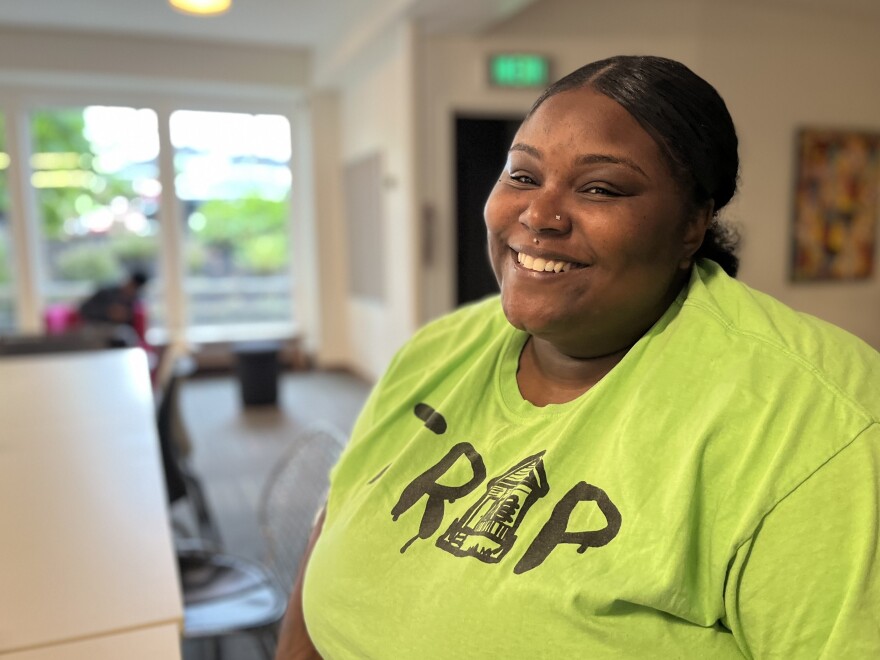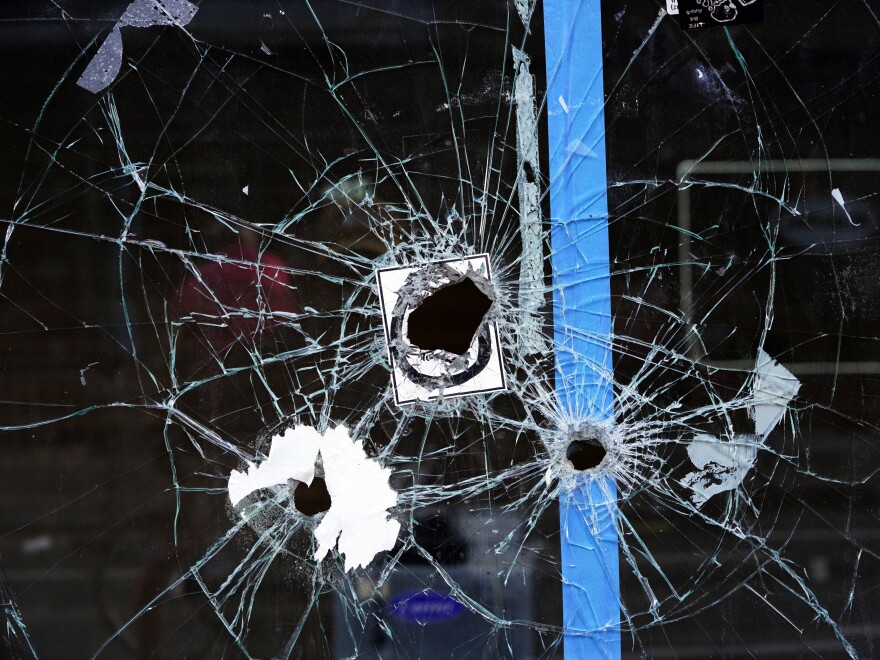SEATTLE — When the U.S. homicide rate jumped nearly 30% in 2020, experts hoped it was a temporary blip — a fleeting symptom of pandemic pressures and civil unrest.
"I lost a couple of people around that time, due to gun violence," says LaMaria Pope, who works for a youth outreach program in the Seattle area called "Choose 180."
Three summers later, she says that violence persists, and young people are more likely to be armed with a gun.
"Sixteen, and 17, 18 and up — they only feel safe if they have one. It's becoming a jacket — they can't leave the house without one," she says.
Hopes for a rapid decline in the pandemic murder spike are fading. National statistics for 2022 aren't yet available, but you can get a sneak peak from an informal year-to-date tally of murders in major cities compiled by data analyst Jeff Asher. The total count in those cities has dipped slightly lower than last year, but it's still well above pre-pandemic levels. And in 40% of the cities listed, homicides are trending higher.
Some of the worst trouble spots are cities such as Philadelphia and Baltimore, where year-to-date homicides are rivaling the high tallies of 2020 and 2021.
In Portland, Ore., the mayor has declared an "emergency" over gun violence, as the city struggles to reel in an annual murder count that shot up to 88 in 2021, from 36 in 2019.
Even some smaller cities, such as Little Rock, Ark., are in danger of eclipsing last year's murder numbers.
"This is definitely not the '90s"
But it's not just that the numbers remain high. The nature of the gun violence itself has changed, according to those who watch these crimes closely.
"This is definitely not the '90s, what we're seeing," says Elyne Vaught, a prosecutor in King County, Wash. He's part of a program called "Shots Fired," which counts and categorizes illegal shootings in a county that includes Seattle. The program seeks to identify people at risk of getting involved in the violence, and intervene by offering social services delivered by non-profits.
"The '90s was more gang-oriented, there was much more organized, sort of targeted shootings," Vaught says. "Today, it's petty offenses, petty conflicts, reckless shootings."
Vaught says you can see the "rise in reckless-type shootings" in the county statistics, where the number of shots fired has more than doubled, compared to the same period in 2019, and with more shots fired per victim.
Police around the country have noticed this trend. A new report from the Major Cities Chiefs Association points to "incidents of individuals indiscriminately shooting into large crowds while discharging massive amounts of ammunition," such as the April mass shooting in downtown Sacramento.
The chiefs point to the availability of extended ammunition magazines, as well as the growing popularity of "auto sear" switches, small after-market devices that turn semi-automatic Glock pistols into illegal automatics, capable of spraying bullets. (Similar attachments are also exist for AR-15-style rifles, but police worry more about handguns, which are used far more often in crimes.)
Post-pandemic "gunplay"
Anecdotally, gunfire has become a more common sound in many urban and suburban areas. Jimmy Hung, chief deputy for the juvenile division of the King County Prosecutor's Office, says he's noticed the change.

"I live in West Seattle and I've never felt, like, leaving my house, I was in danger of being shot — I still don't," Hung says. "But having lived there now for nearly 20 years, I can confidently say that when I sleep at night and I have my window open, I certainly hear more gunshots today than I did when I first moved into the neighborhood."
Hung wonders if those shots are connected to a rise in the "demonstrative" use of guns by young men.
A 16-year-old we're calling "G" recalls being at a party in the same neighborhood — West Seattle — and observing exactly that. (We're withholding his name, given his age and the topic.)
"All we hear is 'pop-pop-pop,' " he says, describing the incident.
He says it started with a dispute between two groups of young people, and took an ominous turn when some came back holding backpacks in front of them, one hand concealed inside.
"That only means, usually, two things," he says. "Either they're having a hard time finding something. Or — it's usually just them holding a gun, ready to pull it out and fire."
Gun violence often starts online
"G" says he doesn't have a gun, and most of the guns he sees in the hands of acquaintances are on social media.
"Mostly Snapchat," he says. "[The videos are] them usually smoking in a car and then holding out a gun, flashing the laser sight. Just saying, 'Hey, I have this, don't mess with me. Be scared of me, basically.' "
When the guns come out in person, he says it's often after warnings online. For instance, someone will post the video of a fistfight, which in turn will prompt others to promise to avenge the loser.
"One of the friends might say, 'Oh, I'm gonna slide for you. I'm going to slide real quick with a pole on me,' " G says, where the term "pole" is slang for gun.
"That usually means, 'Hey, we don't care that you lost, but we're gonna go get the deed done,' " he says.
Temple University criminologist Jason Gravel, who studies how young people acquire and use guns, says the role of social media may be the biggest change of the last few recent years.
"It might look like some random shooting on the street, but if that was preceded by a bunch of verbal threats online or in social media, you don't see the first part of the conflict, you just see the end result," Gravel says.
More guns, more shootings?
At the "Choose 180" program in suburban Seattle, Lemaria Pope thinks the year-long closure of in-person schooling in the region led to many kids discovering guns.
"Kids were finding their parents' guns, because they're in the house, no school, no work. I definitely think during that pandemic, it just opened up a window," Pope says.
There may have been more guns around for kids to find. Firearms dealers reported record sales during the pandemic, and a recent article in the Annals of Internal Medicine estimates that 2.9% of U.S. adults became new gun owners. By extension, the authors estimate 5 million children were "newly exposed" to firearms in their households.
At the prosecuting attorney's office, Hung believes irresponsible gun owners are part of the problem.
"I don't believe that we have emphasized or prioritized enough the secure storage of guns or the responsible ownership of guns," he says. "And so kids are gaining access to guns either through, you know, theft or people misplacing them and them just getting in the wrong hands."
Less risk of getting caught
Others reject this explanation for heightened gun violence, saying people who want guns have always found ways to get them.
Anthony Branch, 26, got into trouble for carrying a gun when he was a teen. Watching the gun culture in his neighborhood, he thinks more minors and felons are carrying guns illegally now for one simple reason: "Defund the police," as he puts it.

"They're only going to search for priorities," he says of the Seattle Police Department, which lost hundreds of officers after the protests that followed the 2020 murder of George Floyd by police in Minneapolis.
At the same time, he acknowledges the violence itself may also be a deciding factor.
"What are you gonna do when you win the fight, and somebody shoots you? Or you have a beef that's so bad that you lose the fight, and they still shoot you?" he asks. "So that's why you have all these young people — and older cats too — want to carry so much. Because of the uncertainty of it."
Criminologist Gravel says society should take seriously the fact that people in certain communities feel so unsafe, they want to carry guns.
"When you look at the rates of violence, if you lived in that community, I don't know if I would blame you if you wanted to carry a gun for protection," he says. "It's not entirely irrational to do so, even if it puts them more at risk."
As to the question of whether the pandemic-era violence is here to stay, Gravel says the jury is still out.
"There's a lot of research that suggests that violence is kind of operates like a contagion," he says. "It's going to take a while until the chain of conflicts that started in 2020 ends — and it might never end! It might take a while for it to die down on its own if we don't intervene and try to stop these conflicts before they happen."
Copyright 2022 NPR. To see more, visit https://www.npr.org.




